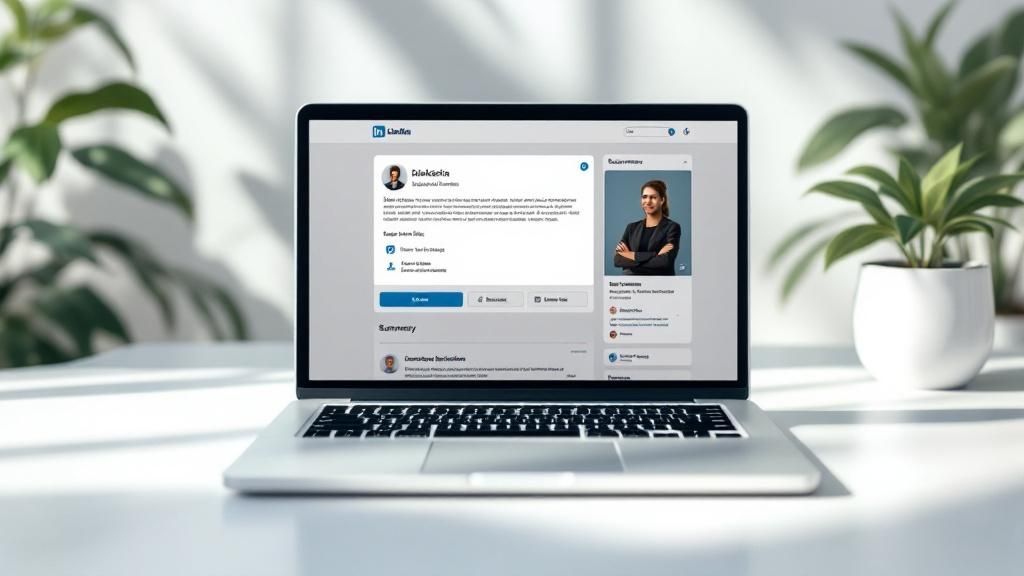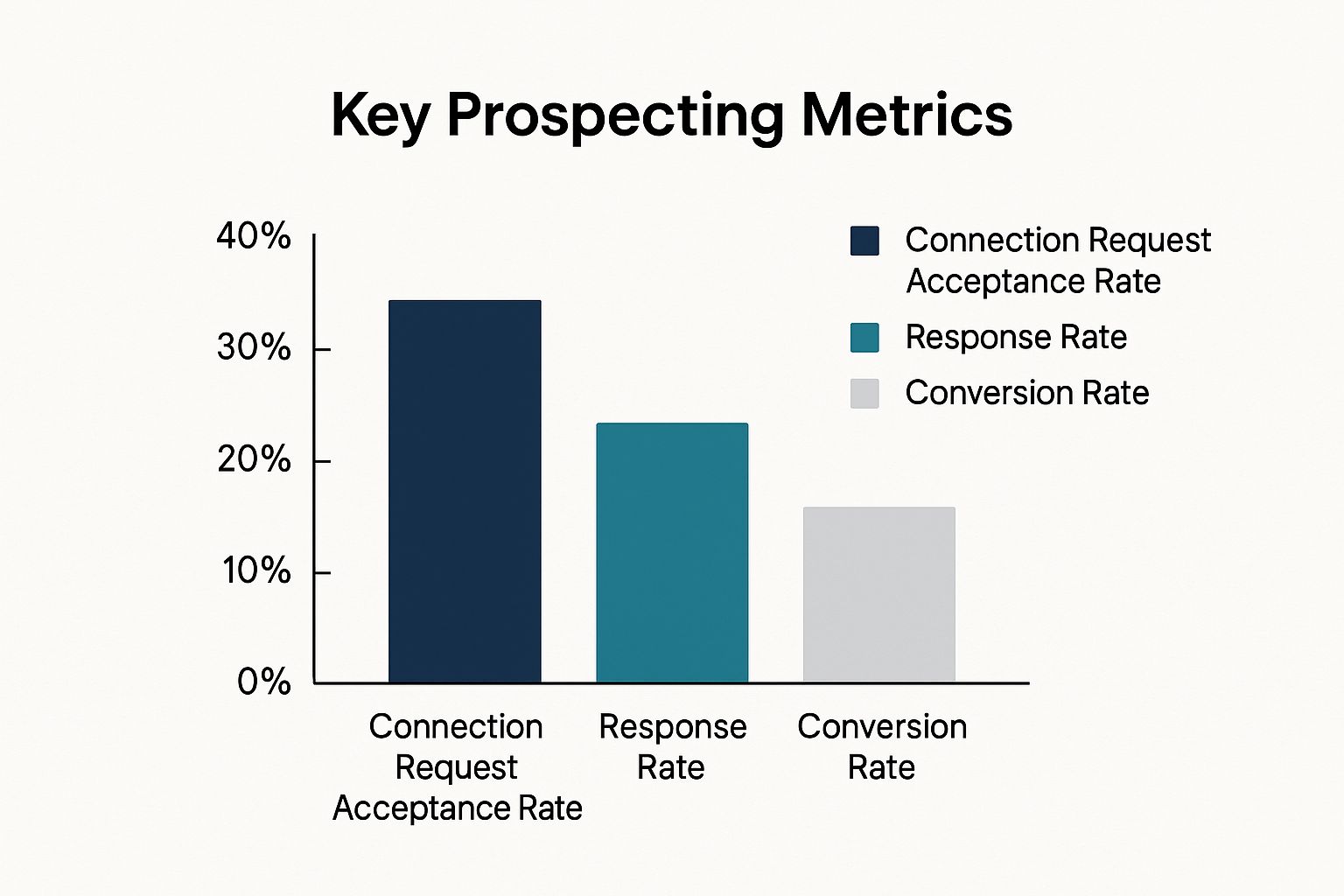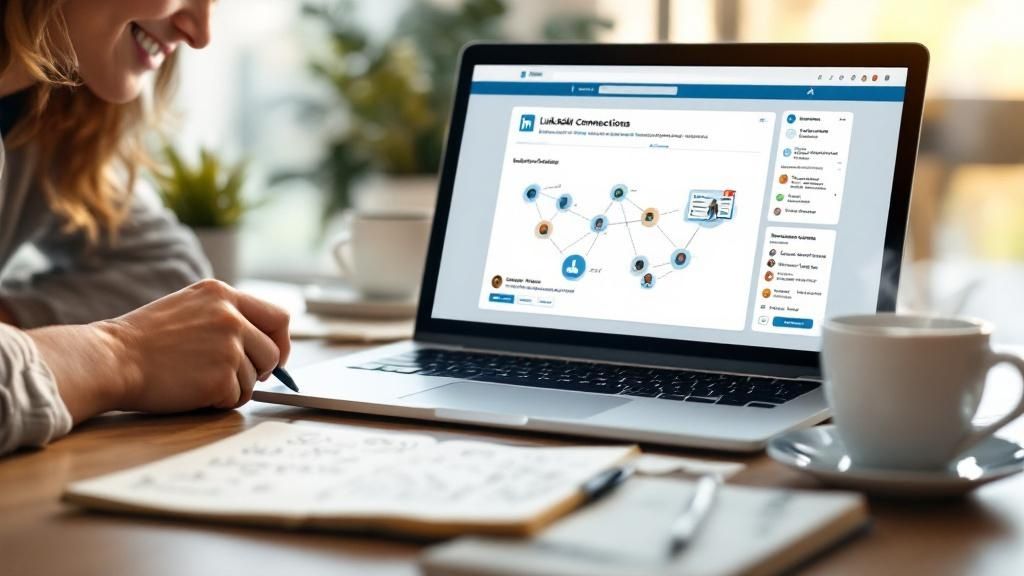Why LinkedIn Prospecting Works When Everything Else Fails
Let's face it, traditional sales outreach can feel like a lost cause. Cold calls go straight to voicemail, emails disappear into the abyss, and you start to question if anyone's out there. That's where the magic of LinkedIn prospecting comes in. It's not a silver bullet, but it is a completely different approach that delivers. While other reps are fighting overflowing spam folders, smart prospectors are building real relationships that turn into closed deals.
I've spoken with tons of sales professionals who've revitalized their pipelines by prioritizing LinkedIn. They've shared their secrets, and the main idea is surprisingly simple: treat LinkedIn like a place to build relationships, not a broadcasting platform. Think about it. How often do you accept a connection request from someone who's clearly just trying to sell you something? Now compare that to the connections you do accept—the ones who offer valuable insights, engage in meaningful conversations, or share relatable experiences. That's the key difference.

This screenshot shows a typical LinkedIn feed with various posts from connections. Notice the mix of content—articles, job updates, industry news—which shows the different ways you can interact with your network. It's about being part of the conversation, not just barging in with a sales pitch. That's why people on LinkedIn will respond when they wouldn't dream of picking up a cold call. They're already thinking about their careers, open to networking, and ready for genuine connection.
This change in mindset has been incredibly successful. LinkedIn has become essential for B2B prospecting, with 53% of B2B marketers using it to find prospects and get contact info. As of 2025, LinkedIn has over 1.2 billion members. This huge reach, paired with 1.77 billion monthly visits, makes it a perfect place to connect with potential clients. Discover more insights.
Making LinkedIn Work for You
This doesn't mean it's easy. There's a learning curve to mastering LinkedIn prospecting. But the rewards are worth it. You might be interested in: Mastering LinkedIn Prospecting. Building authentic relationships takes time and effort. But when you focus on providing value, engaging thoughtfully, and truly understanding your prospects' needs, you'll see a noticeable jump in engagement, conversations, and ultimately, sales.
You'll build a pipeline full of warm leads who are genuinely interested in what you offer, not just trying to dodge your next call. This leads to better conversations and a higher conversion rate than any cold outreach campaign.
To illustrate this further, let's look at how LinkedIn stacks up against other prospecting channels. The table below compares response rates, cost-effectiveness, and the potential for building lasting relationships across different methods.
LinkedIn vs. Other Prospecting Channels Comparison
| Channel | Average Response Rate | Cost Per Lead | Relationship Quality | Time Investment |
|---|---|---|---|---|
| Moderate to High | Low to Moderate | High | Moderate | |
| Cold Calling | Low | Moderate | Low | Low to Moderate |
| Email Marketing | Low | Low | Low to Moderate | Low |
| Paid Advertising | Varies | Moderate to High | Low | Low to Moderate |
As you can see, LinkedIn offers a compelling balance. While it requires a moderate time investment, the potential for building high-quality relationships and the relatively low cost per lead make it a powerful tool in your sales arsenal.
Creating a Profile That Draws Prospects to You
Your LinkedIn profile is essentially your digital first impression when it comes to prospecting. It's the difference between sparking a conversation and being ignored. So instead of just listing your past jobs, think about showcasing the value you bring right from your headline.
This isn't about bragging; it's about strategy. The profiles that consistently pull in high-quality leads all do one thing: they position the person as a trusted advisor, not just another salesperson. This starts with your profile picture. Make sure it’s approachable, professional, and conveys trustworthiness. Ditch anything too casual or posed.
Crafting a Compelling Summary
Think of your summary as your elevator pitch—short, sweet, and compelling. Don’t try to sound impressive. Instead, focus on showing you understand your prospects’ pain points and how you solve them. Zero in on the specific problems you tackle and the results you deliver. For instance, instead of "I'm a sales expert," try something like, "I help SaaS companies boost close rates by 20% with laser-focused prospecting strategies."
Here’s a profile that gets it right:

It instantly communicates value by highlighting specific wins and quantifiable results. The headline clearly defines the target audience and the benefit offered, and the summary expands on this with a concise and engaging overview of expertise. This makes the profile a magnet for prospects looking for solutions in that particular area.
Showcasing Social Proof
Recommendations and endorsements are like gold. They're testimonials that build trust and validate your expertise. Actively seek recommendations from happy clients and colleagues, and prioritize endorsements for skills you want to highlight to your ideal prospects. This adds credibility and strengthens your position as an expert in your field.
Also, make sure your profile is optimized for search. Sprinkle relevant keywords throughout your headline, summary, and experience sections. Think about the terms your ideal prospects would use when searching for someone with your skillset. This helps you show up in the right searches and gets you noticed by potential clients. You might find this helpful: Optimizing Your LinkedIn Profile for Lead Generation.
Your profile isn't a static resume. It's a dynamic prospecting tool that can do the selling for you before you even send a message. Focus on value, authenticity, and strategic optimization, and watch the right prospects come to you.
Finding Your Best Prospects Before Your Competitors Do
The difference between a prospector who's killing it and one who's struggling often comes down to targeting. Sending generic messages to everyone just doesn't cut it. The best prospectors know how to find the people who are actually ready to buy.

This infographic shows how connection requests, responses, and conversions go way up when you personalize your outreach. Getting real results means targeting the right people with the right message.
Using Advanced Search Techniques for Prospecting on LinkedIn
Basic keyword searches? Those are for amateurs. If you want to find the hidden gems your competitors are missing, you need to use advanced search techniques on LinkedIn. That means going beyond simple job titles and using the power of Boolean search.

This is the LinkedIn search interface. It looks simple, but the real magic happens when you combine filters and Boolean operators like "AND," "OR," and "NOT." Let's say you're looking for Sales Managers in the SaaS industry in New York City. Searching for "Sales Manager" AND "SaaS" AND "New York City" will give you a much more focused list than just searching for "Sales Manager."
Think about your perfect customer. What industry are they in? What's their seniority level? What problems are they trying to solve? Use these details to create laser-focused searches. Seriously, it makes a world of difference.
Identifying Buying Signals and Timing Your Outreach
In sales, timing is everything. Knowing how to spot buying signals gives you a serious advantage. For example, imagine a prospect recently posted about needing a new CRM. That's a much hotter lead than someone who hasn't mentioned anything related to your product.
Here are some signs to watch out for:
- Job changes: People in new roles often have new needs.
- Company growth: Expanding companies are often more open to new solutions.
- Industry trends: Knowing what’s happening in your target market is crucial.
Also, think about when you're reaching out. Are you contacting prospects when they're most likely to be online and receptive? Test different days and times to find what works best.
Leveraging LinkedIn Groups and Company Pages
LinkedIn groups and company pages are packed with valuable intel. They can help you find prospects, understand what they need, and even get a feel for their company culture.
Join relevant groups and keep an eye on the conversations. This can help you find prospects who are actively involved in industry discussions. You can even demonstrate your expertise by contributing valuable insights. Following your target companies' pages keeps you updated on their latest news, initiatives, and potential needs.
To attract prospects, building a strong brand is key. Check out this guide on how to effectively create a personal brand.
Lookalike Prospecting: Finding More of Your Best Customers
Lookalike prospecting is incredibly powerful. Find your best customers and use their profiles as templates to find similar prospects. What are their job titles, skills, and interests? What groups do they belong to? Where do they work?
Use this information to create highly targeted searches and build lists of prospects who are likely to have similar needs and buying behaviors. This can dramatically improve your conversion rates and help you focus on the most promising leads.
By combining these strategies, you'll create targeted lists that convert so well, your competition will wonder what your secret is. Remember, effective prospecting on LinkedIn isn't about getting lucky—it's about strategy, precision, and building real relationships.
Connection Requests That Actually Get Accepted
Let's be honest, most LinkedIn prospecting falls flat. Why? Generic connection requests that scream "sales pitch!" The top prospectors out there, the ones with acceptance rates above 80%, understand the psychology behind a "connect" click. They get why some requests are instantly accepted while others, seemingly identical, are ignored.

Take a look at the LinkedIn messaging interface. Notice the limited space for connection requests? This highlights why concise, compelling messages are so important. You absolutely need to stand out.
The Power of Personalization in Prospecting on LinkedIn
Personalized messages are everything. Think about it: Would you accept a request that's clearly a copy-and-paste job? Nope. Your message needs to feel human, not automated. And this means more than just dropping in their name.
Authentically referencing shared connections, mentioning something specific you admire about their work, or commenting on a recent post that resonated with you all make a difference.
For example, ditch the "I'd like to connect" for something like, "I was impressed by your recent article on [topic]. Your insights on [specific point] were particularly insightful, and I'd love to connect and learn more about your work in [area]." See the difference? It shows genuine interest and sets the stage for a real conversation.
Want to dive deeper? Check out this guide: Crafting LinkedIn Connection Requests That Get Accepted. It’s packed with strategies to turn requests into accepted invitations and the start of valuable relationships.
Finding the Right Tone and Length
One size doesn't fit all. Tailor your message length and tone to the individual prospect. Some prefer short and sweet, others value a more conversational approach. For a busy executive, keep it brief and value-driven. For someone in a more collaborative role, a slightly longer message focusing on shared interests could be more effective. Experiment to find what works best.
Timing matters too. Connecting during business hours shows professionalism. Avoid late nights and weekends—respect their time.
Once you know your ideal prospect, think about how finding microinfluencers can help you reach them.
Leading With Value vs. Keeping It Simple
Leading with value can be a winning move. Offer a helpful resource, a relevant introduction, or a unique industry insight. But don’t overthink it. A simple, genuine message can be just as powerful. The key is to avoid anything that feels forced or overly promotional. Focus on building rapport, not closing a deal.
Remember, the end goal isn't just getting connected. It's about starting relationships prospects actually want to continue. By focusing on personalization, thoughtful timing, and genuine connection, you can significantly boost your acceptance rate and build the foundation for meaningful business conversations.
Turning Connections Into Real Business Conversations
Connecting on LinkedIn is just the starting line. The real power of LinkedIn prospecting comes after you've connected. So many people mess up this critical follow-up, either disappearing completely or jumping right into a sales pitch. Neither works. Let's talk about turning those connections into actual business conversations.
Building Relationships, Not Just Pitching Products
Think about your own LinkedIn experience. What's your reaction when someone connects and immediately pitches you their product or service? You probably roll your eyes and archive the message. Now, think about how you feel when someone connects and starts a real conversation, showing genuine interest in what you do and offering helpful insights. That's the difference between spamming and relationship building.
Effective prospectors on LinkedIn understand the follow-up is about nurturing. It's a delicate balance: being helpful while strategically steering the conversation toward a business opportunity. This starts with carefully planning your messaging, from that first follow-up to the questions that uncover real pain points.
The Art of Providing Upfront Value
A great way to build trust is offering upfront value. This could be sharing a relevant article, making a helpful introduction, or offering a unique industry insight. Think about what your prospect would genuinely appreciate, not just what promotes your product.
For example, imagine you connect with a marketing manager who recently posted about struggling with lead generation. Instead of pitching your lead generation software, share a helpful blog post on optimizing landing pages. This shows you understand their challenges and you’re willing to provide value without immediately asking for something in return. It builds reciprocity and positions you as a trusted advisor, not just another salesperson.
Navigating the Conversation Flow
Once you've built some rapport, start asking thoughtful discovery questions. These should be designed to uncover your prospect's pain points and identify potential buying signals. Skip the generic questions like "How's business?" Ask specific questions related to their industry, role, or recent activity.
For instance, you might ask, "I saw your company recently announced a new product launch. What are some of your biggest marketing challenges with this launch?" This demonstrates you've done your research and are genuinely interested in their situation. Their answers will give you valuable insights into their needs, so you can adjust your approach accordingly. But, LinkedIn prospecting has its hurdles. In fact, over 64% of sales reps don't achieve their quotas, and 32% see leads go silent. This highlights the importance of effective strategies and benchmarks for LinkedIn outreach. Learn more about LinkedIn outreach benchmarks here.
Recognizing Buying Signals and Handling Objections
As you talk, pay attention to buying signals. These are the subtle clues that a prospect is interested and ready to move toward a sales conversation. These might include asking about pricing, requesting a demo, or expressing a clear need for your solution.
Be ready to handle objections gracefully. Objections aren't necessarily roadblocks; they’re often chances to address concerns and provide more information. Listen carefully to the objection, acknowledge their perspective, and respond thoughtfully to address their specific concern.
Mastering Timing and Follow-Up
Timing and follow-up are key to keeping the conversation going without being too pushy. Don't flood prospects with messages. Follow up strategically based on their responses and engagement. If they show interest in a particular resource, follow up with additional information or a relevant introduction. If they go quiet, send a brief, value-added message to re-engage them.
By mastering these techniques, you'll transform connections into meaningful business conversations that build trust, uncover opportunities, and ultimately, drive sales. Remember, LinkedIn prospecting isn’t just about connecting—it’s about building relationships that lead to long-term business success.
Scaling Without Losing the Personal Touch
So, you've mastered the LinkedIn prospecting fundamentals. Your profile is top-notch, your searches are precise, and your connection requests are getting accepted left and right. But now comes the tricky part: how do you amplify your efforts without turning into a connection request machine? It's a classic dilemma – doing more without sacrificing the personal touch that actually makes prospecting work.
Automating Strategically for Prospecting on LinkedIn
Automation can be a game-changer, but only if you use it strategically. Some tasks are perfect for automation, like sending follow-up reminders or tracking engagement. However, crafting personalized connection requests or having meaningful conversations? That's where human intuition and creativity still reign supreme. Think of automation as your trusty assistant, handling the tedious tasks so you can focus on building genuine relationships.
There are platforms built specifically to manage large-scale outreach without sacrificing personalization. Salesloop, for instance, lets you tailor messages at scale and automate follow-ups, all while staying within LinkedIn's terms of service. This is crucial to avoid getting your account flagged for spamming.
This Salesloop dashboard screenshot shows how you can manage outreach campaigns, personalize messages, and track key metrics. The clean interface and clear data visualization make it easy to see your progress and tweak your strategy based on real-time results. It's all about actionable insights – focusing on the data points that actually move the needle.
Building Systems for Sustainable Growth
Scaling effectively means having robust systems and processes in place. This could involve integrating your CRM, creating structured workflows, or using team collaboration tools. Imagine it like a well-oiled machine: every component needs to work together seamlessly to handle increased volume without compromising quality.
For example, try integrating your LinkedIn prospecting with your CRM to keep a record of every interaction, from the initial connection to the final closed deal. This centralized view of your pipeline helps you track progress and spot any bottlenecks.
Quality Control and Meaningful Metrics for Prospecting on LinkedIn
As you scale, maintaining quality becomes even more important. This might involve regularly reviewing message templates to ensure they're still relevant, monitoring connection request acceptance rates, or analyzing conversation trends. It's like fine-tuning a recipe – you need to taste-test along the way to ensure the final result is excellent.
And don't forget about tracking the right metrics. Vanity metrics like connection count don't tell the whole story. Focus on the metrics that truly matter – like conversion rates, meeting bookings, and the revenue you're generating. A data-driven approach helps you refine your strategy and focus on what actually works.
Building a Sustainable Prospecting Machine
Scaling isn’t just about doing more; it's about doing more of what works. It's about building a sustainable prospecting system that consistently delivers results month after month. By combining strategic automation with personalized engagement, building efficient systems, and focusing on meaningful metrics, you can scale your LinkedIn prospecting without losing the human touch that makes it so effective.
Your LinkedIn Prospecting Action Plan
Alright, let's get down to brass tacks. How do you actually use all this LinkedIn knowledge to find and connect with potential clients? Think of this action plan as your prospecting playbook, taking you from a polished profile to meaningful business relationships.
Phase 1: Profile Optimization
Think of your profile as your digital first impression—your handshake in the virtual world. You want it to be strong and memorable.
- Headline: Don't just slap your job title up there. Instead, tell people what you do for them. What problems do you solve? What value do you bring? For example, instead of "Marketing Manager," try something like "Helping SaaS Companies Generate Leads and Drive Revenue."
- Summary: This is your elevator pitch in writing. Keep it short, sweet, and compelling. Focus on your expertise and how you help your clients achieve their goals. What makes you different? What's your unique selling proposition?
- Experience: Don't just list your responsibilities. Showcase your achievements. Whenever possible, use numbers and data to quantify your impact. Did you increase sales by 20%? Did you launch a successful product that generated $1M in revenue? Let the numbers speak for themselves.
This initial profile polish is the foundation for everything else. A strong profile attracts the right prospects and positions you as a go-to expert.
Phase 2: Targeted Prospecting
Now that your profile is shining, it's time to find the people you want to connect with. Think laser focus, not shotgun blast.
- Identify Your Ideal Customer: Really drill down on this. What keeps your ideal customer up at night? What are their biggest challenges? What are their goals and aspirations? The better you understand your target audience, the more effective your outreach will be.
- Leverage Advanced Search: LinkedIn's advanced search filters are your secret weapon. Go beyond simple keywords. Use Boolean search operators (AND, OR, NOT) to narrow your search and uncover hidden gems. For example, if you're targeting marketing managers in the SaaS industry, you could use a search string like "Marketing Manager" AND "SaaS" AND "Lead Generation."
- Look for Buying Signals: Pay attention to a prospect's recent activity, job changes, company news, and posts. These can be valuable indicators that a prospect is actively looking for a solution like yours.
Precision targeting is the name of the game. Don't waste time on prospects who aren't a good fit.
Phase 3: Connection and Engagement
Time to reach out and make those connections. But remember, generic connection requests are like spam—they go straight in the trash.
- Personalize Your Messages: Show genuine interest in the person you're contacting. Mention something specific that resonated with you about their work, profile, or a shared connection. Avoid generic templates.
- Lead with Value: Offer a helpful resource, a relevant article, or an insightful comment. Don't just pitch your product or service right off the bat. Focus on building a relationship first.
- Follow Up Strategically: Don't be afraid to follow up, but do it thoughtfully. Provide additional value in each interaction. Maybe share a case study or invite them to a relevant webinar.
Building relationships takes time and effort. Be patient, persistent, and always focus on providing value.
Phase 4: Automation and Scaling
Once you've fine-tuned your prospecting process, it's time to amplify your efforts.
- Automate Repetitive Tasks: Tools like Salesloop can help streamline your outreach, automate follow-ups, and manage multiple campaigns. This frees up your time to focus on higher-value activities like building relationships and closing deals.
- Maintain Personalization: Automation should enhance, not replace, personalized engagement. Use automation to scale your efforts while still maintaining a human touch.
- Track Your Results: Monitor key metrics like connection request acceptance rates, response rates, and conversion rates. This data will help you identify what's working and what's not, so you can continuously optimize your strategy.
Scaling your outreach without sacrificing personalization is key. Tools like Salesloop can help you achieve this balance.
Ready to kick your LinkedIn prospecting into high gear? Start your free trial with Salesloop today!





